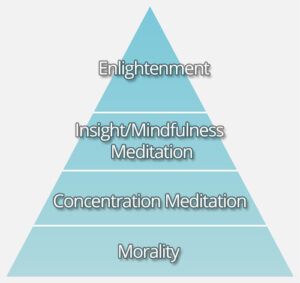The 5 Stages of Meditation
There are five stages of meditation, and each stage increases the power of mindfulness. The first stage is called “mindfulness,” and includes the three core principles: Suspension of logical thought, Interrupted Attention, and Maintaining a self-observant attitude. The second stage is called “mastery,” and involves cultivating skills like exclusive attention. It can take years, but it is well worth the effort.
Mindfulness
In this stage of meditation, your awareness is centered on the present moment. You are observing your breath. You are aware of each moment, from the first movement through the in-breath to the pause between breaths. As your attention remains centered, the entire breathing process becomes a seamless whole. You can also use a trick like ‘calm’ to break the inner silence. Your breath also becomes quieter and more beautiful.
The first milestone is exclusive attention. This requires a lot of effort and patience to develop. Otherwise, distractions will come back, resulting in the failure of the practice. This requires you to practice with your attention until it becomes automatic. Other distractions, such as restlessness, boredom, and involuntary body movements, may cause distractions. The first milestone of meditation is to master the skills of uninterrupted attention. The second milestone is to master your attention span. In this stage, you can learn to define your attention span and consciously ignore distractions. Once you’ve reached this stage, you’ll be able to experience complete meditative joy.
After you’ve reached this stage, the next stage is silent present-moment awareness. In this stage, you’ll think about the five-sense world. This stage is difficult to master because few meditators understand that they’re not moving forward unless they’re not noting their bodily sensations. This process, however, is crucial for the success of meditation. If you’re not aware of your bodily sensations, you’re sabotaging your progress.
First, the mind must be aware of the present moment. This stage is called mindfulness. It requires the mind to be present in the present moment without any desire. The mind is free from aversion and desire. It is a state of being that is free from ego. You can achieve full-on awareness by simply staying aware of your breath in the present moment. For example, you may have a difficult time holding an object while meditating.
As you practice mindfulness, you will experience different types of experiences. You may experience periods of overwhelm and even regression. It’s natural to fall back to earlier stages of meditation. There are no hard and fast rules to get to the end of meditation, and it’s not a linear process. You may feel stuck, or scatter-brained during your practice. But don’t worry! It’s part of the process and will help you build a sustainable practice.
Suspension of logical thought

The goal of the Fourth Meditation is to validate more generally the distinctness and truth-rule of reality. The meditator must realize that there are many ways to get knowledge, and that they must stop relying on logical thought. By doing so, the meditator must recognize the fallibility and finiteness of the mind. Throughout the entire process, the meditator is constantly challenged to examine the reliability of his or her own reasoning.
Interrupted attention
The first three stages of meditation are characterized by varying levels of interrupted attention, or mind-wandering. Throughout these stages, the practitioner is attempting to achieve a single-pointed awareness, or “metacognitive introspective awareness,” where the mind never changes. Though this state is not easy to achieve, it can be cultivated. In a long meditation practice, interrupted attention may be avoided by being aware of the underlying causes of interruption.
As the mind settles and becomes calm, the practitioner may find that their attention occasionally wanders. This wandering is called gross or subtle distraction. While the mind is calm, the sense of intention is not completely absent. When attention wanders, the practitioner can correct the distractions by returning to the original object. While it is important to remain aware of these distractions, the practitioner should also practice finding joy in the present moment and not identify with the feelings of impatience and frustration.
The next stage is called “monastery time.” This is a stage of meditation where the practitioner is fully present. In this stage, he or she is aware of everything, but the mind does not know the time or day. The object of meditation is the same no matter where the mind wanders. This state is called “monastery time” and is one of the most important stages of meditation.
Many meditation practices involve a multi-step process. In order to make the process as simple and easy as possible, many of these methods are based on focusing the individual attention on a particular stimulus. By using these techniques, individuals can better regulate their attention in their own way. This will allow them to become more advanced and achieve greater meditative accomplishments. These techniques, however, require certain conditions to be fulfilled and will be affected by events outside of meditation.
The goal of meditation is to train the mind to be more stable. Stable attention and mindfulness are the result of a process of continuous practice. A common meditation object is the breath. Breathing is a constant, subtle detail. The goal is to cultivate a habit of mind that will last forever. But this requires discipline. The practice of meditation begins with cultivating the intention. The practice of mindfulness begins with a clear intention, a specific meditation object, and a dedicated focus.
Maintaining a self-observing attitude
Infrequent meditation is a stage in which a person develops self-observation. Infrequent meditation can be characterized by a tendency to identify with an unpleasant event or with oneself. It may also be characterized by a strong feeling of social distance. These stages are often distinguished by differences in dispositional attributions and affect, but they are all related to the development of self-observation.
The observer’s attention moves away from Gross Objects and focuses on the Subtle elements of the mind. It then wraps itself around a feeling of deep bliss. The observer aims to experience the Subtle aspects of individuation. This is a difficult stage to achieve consistently. However, it is necessary for the development of meditative practice.
Gross and Subtler Objects are both important in the practice of meditation. In Gross meditation, the observer uses a mantra, visual images, or other means to bring about a more inward experience. In Subtler meditation, the observer observes the process and the Observed. The latter is a more subtle aspect of the meditation process. Observing the process is a vital step in meditating, and is one of the 5 stages of meditation.












